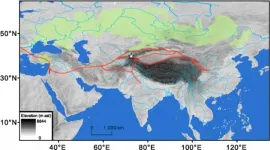(Press-News.org) After more than 1,000 orthopaedic procedures at a city health system, roughly 61 percent of the opioids prescribed to patients went unused, according to new research. This was discovered within a study at the Perelman School of Medicine of the University of Pennsylvania that showed most patients responded to text messages designed to gauge patients' usage of their prescriptions. Knowing that so many patients are comfortable texting this information to their care teams is extremely useful as medical professionals look to right-size painkiller prescriptions and reduce the amount of opioids that might be misused when they're left over. This study was published in NEJM Catalyst.
"This approach is a step toward building a dynamic learning health system that evolves to treat patients," said the study's lead author, Anish Agarwal, MD, an assistant professor of Emergency Medicine. "We know that the opioid epidemic has struck the nation in many ways. One of the key areas to address is reducing the amount of 'leftover' opioid pills in the community which pose a risk to individuals, families, and children."
Clinicians know that a balance needs to be struck between pain management and opioid pain medications, but there is little by way of patient data to guide them. Opioid prescription quantities have largely been best estimates based on how clinicians were trained or a rough estimate using a patient's medical history. Agarwal, senior author M. Kit Delgado, MD, co-chair of the Penn Medicine Opioid Task Force and an assistant professor of Emergency Medicine, and their colleagues sought to fine-tune those estimates and adjust guidance on a procedure-by-procedure case. To do that, they sought a way to deliver real-time numbers on how much pain medication patients actually use. The system they developed centered on automated conversational text messaging.
Patients were recommended to join the automated system by their clinical team, then would receive text messages introducing them to the program on the fourth day following their procedure. If the patient responded that they'd like to take part, the automated system triggered a simple text conversation. It asked questions about things like patients' levels of pain, their ability to manage the pain, and their use of their prescription opioids. These messages were set to go out on the fourth, seventh, fourteenth, and twenty-first days after their procedures. If patients indicated at any point that they weren't taking the opioid pain medication anymore, the messages stopped.
The research team reached out to roughly 2,400 patients of orthopaedic procedures between September 2018 and January 2020. Roughly half consented to taking part in the program, which, in itself, was a significant finding for the researchers because it showed a widespread willingness to use this type of system. On top of that, the researchers saw an extremely high rate of responses among these patients with 88 percent responding on the fourth post-operative day. The lowest rate of responses was seen on the patients' seventh day (at 69 percent). For those patients using medications at day 21, 95 percent responded.
Overall, patients reported a decrease in their pain levels across all procedures. But this appeared to be accomplished without the majority of the opioids that were prescribed. More than 1,100 patients took part in the texting system, and from that population, the researchers discovered that more than 10,000 opioid tablets were left unused, roughly 61 percent of those that had been prescribed. While research is slim on the subject, that is within the range, though on the higher end, of what is thought to be the average amount of leftover opioids from medical procedures.
Agarwal believes that through establishing a system like this - which patients took up at high rates - gives clinicians a patient-centered, real-time feedback system that could be used to adjust opioid prescription levels and reduce the chance of their being leftover pills that could be misused.
"Our system works as a quality improvement mechanism and a way for providers to see trends in patient-reported pain and opioid use following their surgeries," Agarwal said. "We can collect the data, analyze it, and inform future prescribing to predict and meet the needs of our patients going forward."
One of the goals of the team researching this texting system is to potentially pinpoint what levels of opioids would be needed for each type of procedure. For instance, current prescribing practices may be overshooting the pain management needs of a shoulder surgery patient, but roughly right for someone getting a hip replacement.
"As orthopaedic surgeons, we are always concerned that we will not provide enough medicine to care for our patients' post-operative pain. In the past, it was truly a calculated guess erring on the side of not underprescribing," explained study co-author Brian Sennett, MD, the chief of Sports Medicine and an associate professor of Orthopaedic Surgery at Penn Medicine. "Our goal is to treat our patients well while not overprescribing. In the future, I am excited about sharing this data with our patients and having them involved in their post-operative pain management, which I believe will result in the next great reduction in opioid prescribing."
Although this study used orthopaedic surgeries to test the system, Agarwal said it opens the door for pain management observations across many departments.
"This is the beginning of a lot of exciting work supported by many Departments, the University, and the FDA," Agarwal said.
INFORMATION:
This study was supported by the U.S. Food and Drug Administration (HHSF223201810209C).
Other authors include Zarina Ali, Ruiying Xiong, Jessica Hemmons, Evan Spencer, Hannah Lacko, Eric Hume, and Samir Mehta.
BOSTON -- Numerous studies have demonstrated the role of physical activity in improving heart health for patients with type 2 diabetes. But whether exercising at a certain time of the day promises an added health bonus for this population is still largely unknown. Now, research published in Diabetes Care by Brigham and Women's Hospital and Joslin Diabetes Center investigators, along with collaborators, reports a correlation between the timing of moderate-to-vigorous physical activity and cardiovascular fitness and health risks for individuals who have type 2 diabetes and obesity or overweight.
The research team found that, in its study of ...
A nasal antiviral created by researchers at Columbia University Vagelos College of Physicians and Surgeons blocked transmission of SARS-CoV-2 in ferrets, suggesting the nasal spray also may prevent infection in people exposed to the new coronavirus, including recent variants
The compound in the spray--a lipopeptide developed by Matteo Porotto, PhD, and Anne Moscona, MD, professors in the Department of Pediatrics and directors of the Center for Host-Pathogen Interaction--is designed to prevent the new coronavirus from entering host cells.
The antiviral lipopeptide is inexpensive to produce, has a long shelf ...
An engineered peptide given to ferrets two days before they were co-housed with SARS-CoV-2-infected animals prevented virus transmission to the treated ferrets, a new study shows. The peptides used are highly stable and thus have the potential to translate into effective intranasal prophylaxis to reduce infection and severe SARS-CoV-2 disease in humans, the study's authors say. The SARS-CoV-2 spike (S) protein binds to host cells to initiate infection. This stage in the virus life history is a target for drug inhibition. Here, researchers with past success designing lipopeptide fusion inhibitors that block this critical first step of infection for SARS-CoV-2 and other viruses sought to design ...
Tsukuba, Japan -- As March comes around, many people experience hay fever. As excessive immune responses go, most would admit that hay fever really isn't that bad. At the other end of the spectrum are severely debilitating autoimmune diseases like rheumatoid arthritis and multiple sclerosis. A common thread in all these conditions are cytokines, molecules that cause inflammation. Recent research by the University of Tsukuba sheds light on the effect of excessive cytokines on neuronal and glial cells in the brain.
Researchers led by Professor Yosuke Takei and Assistant Professor Tetsuya Sasaki at the University of Tsukuba in ...
Meteorologists frequently study precipitation events using radar imagery generated at both ground level and from satellite data. Radar sends out electromagnetic waves that "bounce" off ice or water droplets suspended in the air. These waves quickly return to the radar site in a process named "backscattering." Scientists have observed that backscattering reaches its peak during the melting process as water falls through the atmosphere. High backscattering typically results in warm color returns on a radar displays, indicating heavy precipitation.
However, recent case studies noted that partially frozen droplets seem ...
Cryptomeria japonica, or the Japanese cedar, is highly revered as the national tree of Japan. Locally known as "sugi," it covers over 4.5 million hectares of land, accounting for nearly half of Japan's artificial forests. However, it is also notorious for causing hay fever, with a good 26.5% of Japan's population reporting cedar pollen allergies in 2008. Over the past years, pollen allergy caused by this conifer has become a widespread social issue among Japanese residents, with many having to avoid going outdoors during pollen season.
As sterile trees cannot produce and release functional pollen, it is believed that breeding of male-sterile cedar trees could be crucial in reducing the pollen released ...
A team of MedUni Vienna researchers led by Johannes A. Schmid at the Center for Physiology and Pharmacology, Institute of Vascular Biology and Thrombosis Research, has managed to identify a previously unknown molecular connection between an inflammatory signalling molecule and one of the main oncogenes. The study has been published in the leading journal "Molecular Cancer".
Johannes A. Schmid's working group at the Center for Physiology and Pharmacology, Institute of Vascular Biology and Thrombosis Research, already has many years' experience in the molecular ...
The Silk Road was the most elaborate network of trade routes in the ancient world, linking ancient populations in East Asia to those in southwest Asia, via Central Asia. These trade routes fostered the spread of ideas, religions, and technologies over the past 2,000 years. Before the establishment of organized exchange, starting around the time of the Chinese Han Dynasty (2,223 years ago), a process of trans-Eurasian exchange was already underway through the river valleys and oases of Central Asia. The establishment of populations in the oases of the Taklimakan Desert ...
Cardiovascular system can be regarded as a mechanical system centered on the heart. Blood flow in the vascular system, hemodynamics factors within the vasculature contain wall shear stress, circumferential wall tensile stress and hydrostatic pressure. Mechanical forces play an important role in vasculature and circulation, such as rapid regulation of vascular wall elasticity, administration of vascular remodeling, and the formation of arteriosclerotic lesions. Stress stimulation within the physiological range enables cells in dynamic balance to maintain homeostasis of vascular morphology, structure and function. Inversely, abnormal stresses stimulation, such as low shear stress, disturbed shear stress and high tensile strain, can break this balance ...
More people than expected ended their own lives in 2020 in Japan, overturning a decadelong slow decline in the nation's annual number of suicides, according to a new analysis by public health experts at the University of Tokyo. The increase in suicides was especially pronounced among women younger than 30, potentially due to the COVID-19 pandemic's disproportionate effect on part-time and travel industry employees.
"This trend of increased suicides among young women and university and high school students is very different from before COVID-19. Before COVID-19, if suicides increased, we would expect more deaths of middle-aged men," said Dr. Haruka Sakamoto, an expert in public health at the University of Tokyo and first author of the research publication in the Journal of the ...



